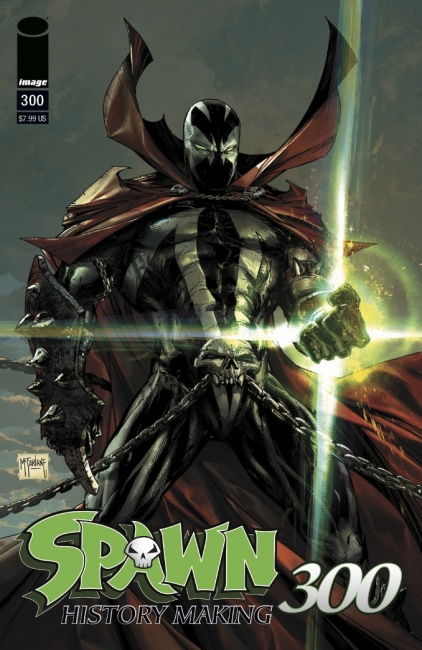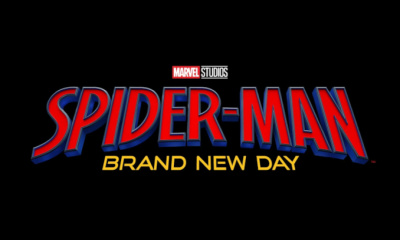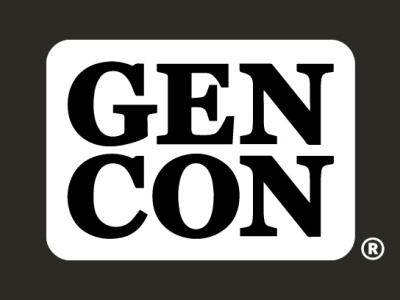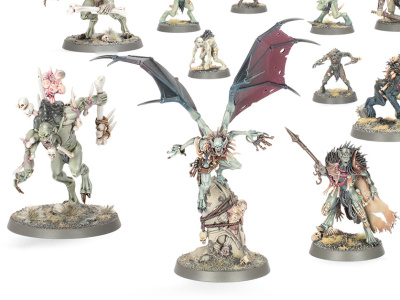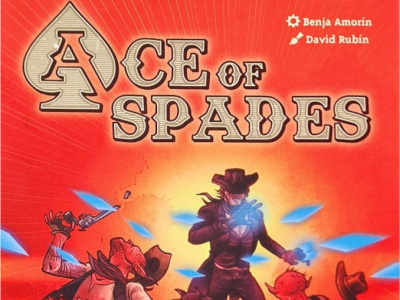We got a chance to sit down with McFarlane Toys CEO and Image Comics partner Todd McFarlane at Toy Fair. In Part 2 of this two-part interview, we talk about achieving the landmark 300th issue of his title Spawn, his thoughts on the current state of the comics business, repeated #1s vs. long runs, the growth of graphic novels, the future of comics, the Spawn movie, and the future of the Spawn comic. In Part 1, we talked about the beginnings of McFarlane Toys, how the toy business has evolved over the years, and the key products from the company’s 2020 line (see "Preview: McFarlane Toys at NY Toy Fair").
Let's talk about comic books a little bit. Obviously, you had a big event in 2019, which was achieving a new thing that's never been achieved before (see "Landmark Issue of ‘Spawn’"). Talk about that, and what it means to you in your career in comics.
There's a couple things. We had issue #300. Any anniversary book is an achievement in and of itself. Sometimes we raise a flag at the 50 mark, too, 100, 150. But the ones with zeros on them, those are always cooler. We hit Spawn #300, which I was able to do a little bit of a play with some of the covers and stuff that mimicked and parodied some of the stuff I did on Amazing Spider-Man #300. It was easy to get people a little bit involved.
Then, one of the things that I wanted to do was to see if I could build upon the easy piece, which was going to be Spawn #300, the anniversary book. I knew it was going to sell, because anybody that gets to the 300th issue, people are going to up their orders. But when I went to the Retail Summit. Come on, guys, let me see if I can help you on a broader scale. Let's think for six months, not one month, and here's how it works.
Issues #296 and #297 are essentially a Reader's Digest version of the first 300 issues. For all the people that are coming to you, "I missed out on so many issues. I can't. I'm behind. I don't know the mythology," give them #296, #297. They're caught up to speed.
Now that they're caught up to speed, #298 and #299 is the prelude to #300. And they're going to have some parody covers that match my #298, #299 covers of Spider-Man, which was the beginning and the launch of my fame and fortune, if you will.
Then we get to the big boy, the 300. Oh, by the way, the #300 book is going to be a killer, because I'm going to have Greg Capullo come back, who is to me the preeminent Spawn artist. I'm going to have J. Scott Campbell, not just do a cover, but do the inside. Anybody who did a cover will do the insides. There's not going to be any lone rangers on #300. I convinced everybody that if you want to do a cover, you have to do some interior artwork.
So, that one is going to be a home run. Then #301, you have to buy it, because the end of #300 is a cliffhanger. So, just store-wise you have to buy a lot of #301. It's going to be a record-setter, and here's why it's going to be a record-setter. Dave Sim did Cerebus, did 300 issues. Now, we're going to have issue #301, which is the longest running creator-owned book in the history of mankind. So, I'm quite proud of that, especially as somebody who has been wailing off and on forever, seems like, about creator rights, officially since '92 when we formed Image Comics, and every issue thereafter now becomes that one.
So, there is a way for me to take what normally would be a one month hit, and turn it into a bit of a story to the retailers. That ended up happening, because I got a bounce. I got a bounce on #296, #297. I got a big bounce in #298, and #299. Crushed it with #300, that was the second highest-selling book of the entire 2019 year. #301 was number 11. The only title in the top 11 twice is Spawn. It wasn't a Marvel book. It wasn't a DC book. It was Spawn.
I was able to do it so that now there's a new floor to the sales of Spawn, which is dramatically higher than what it was prior to those six months. That's all anybody is trying to do on a business level is just keep solid sales.
What are your reflections on the current state of the comics business, especially given your, at this point, long career, both working for the big companies and then starting Image Comics.
I think we unintentionally discredit quality product over gimmicks.
I get it. If you do a crossover, you're going to get the big numbers. I get it if you renumber your book and you put a number one on it, you're going to get a momentary hit.
But it's still momentary. I have these debates sometimes with people, both Marvel and DC. They're like, "Yeah, Todd, but when we relaunch it, then we get this pop." It's like, you get the pop, but then the very next issue or by issue number three, you're back down to where you were before. It's momentary.
Oh, by the way, let me just ask you a simple question. Are you selling more comic books today than you were 10 years ago? And we know what the answer is.
So, I don't give a shit how many tricks you do. You're selling less comic books, minus the trick. If you can augment it with a bunch of tricks to get you past, then you go, "but our sales per average is up." It's up in a false way, instead of just putting out the quality product.
People will come. People will buy a quality product. Spawn #300, and I think it was a quality product, because I went and got Greg Capullo, and J. Scott Campbell, and Jason Alexander and Jerome Opena, and I even did some pages. I put a quality product in front of people, and it's issue #300. Come on. And they came back. This thing has been going for 27 years. They came back, to the tune of it being the second highest ordered book, period. That's not even accounting it was a $7.99 book on top of it.
They'll do it. You guys keep thinking that you have to trick them into the pot. Just put a good product out there.
Every book that all of us are arguing about, that we go, what was your favorite book. John Byrne's X‑Men, Frank Miller's Daredevil, whatever. Even what Bendis did with Alex Maleev on Daredevil. There's all these runs, there's all these runs that all of us, you have your favorite.
None of it was based on trickery. None of it was based on because it crossed over ten other books. They're just your favorite book that you just bought.
I don't see why humans evolved differently since I left 20 years ago, that they still won't respond to good quality product. They do, because we put out 60, 70 books at Image every month, and some of those percolate very high up. Some of them even get made and bought into Hollywood.
People will respond. I don't know why they need to keep doing it.
By the way, if the only reason is because you think you have so many consumers who only buy a number one, I'm going to literally start doing a number one on every one of my comic books.
I'm going to have #306 in one corner, and #1 in the other corner. Then #307, and #1 on the corner. If you need a #1 to sell it, I'll put a one on it for you.
They do one‑shots. That was our big takeaway from San Diego last year. All of the sudden everybody's doing one‑shots. Well, because #1s sells.
It's worse than that. They're doing so much relaunch and so many #1s that I think they're cannibalizing the ones that actually are #1s, that are high quality, that are getting lost because there's so many of them.
You look at the charts. There are now #1s, issue #1s, of a Marvel and DC book that are sitting in the 90, 100, 112 [rank] range that are #1s. Why? Because there's 37 #1s from that company that month.
You can't consume all that. It's like going into a candy store. Much as I'd like to buy it all, I can't eat and consume it all, and I can't afford it all, more importantly. Even if I could consume it, I can't afford it. So, it's overkill to me.
It's easy for me to say, because, A, I'm not a public company, and I'm not owned by a public company, and I don't have the pressures of a public company, and I don't have 100 books. I can grind on my two, three books, and just make sure that they're doing what I want them to do and be out. I live a different pace than they do.
You have people that have bought every Spawn. They collect the run. When you restart every time, that's maybe an opportunity to bring in new people, but you also lose people.
No, it's an opportunity for somebody to quit. Come on, you and I were collectors. You know this to be true. How many titles did you have that you bought that you collected because you had the last 50 issues?
That was the sole reason you were buying it. For me, it was. I'm going, "Do I really like Weird War comics? Or is it because I've got issues 1 through 60?"
It gets you through the creative soft spots, right? To hang on for the next one.
Right, right. But the moment that they started doing some relaunching when I was younger, then I went, you know what? I don't need a Weird War #1. I don't need this #1.
Look, here's what I know about addiction. You want your friends to be addicted to your product, so they keep coming back. You never want to give them a chance to live a day or six months without the addiction. If you say you're going to stop it and relaunch it in five months, the addiction has been broken, and they know that they can live without it now.
You need to keep pumping it out, to just go, no, I can't live without this comic book with these people on it. When you take it away, when John Byrne left X‑Men, it took me seven years to get over that. I kept thinking he's coming back.
I still have people ask me almost 30 years later, "You going to draw Spider-Man again?" They're still hoping.
One big phenomenon we've been covering a lot at ICv2 is the growth of the graphic novel format, which is now bigger than the comic format has been for a while. Any thoughts on that, periodical business versus…?
There's a couple things. Number one, if you look at the main players, North American players, we crush it. Image Comics crushes it. If you look at the top 100 graphic novels, Image almost owns it. We own 40 percent of that. We don't own 40 percent of regular comics. We own 40 percent of that.
Then, even more, if you go to bookstores, the graphic novels, they're not even American-made necessarily. They're selling, and their brand is based on global ideas that are selling hundreds of thousands.
If you're talking the North American stuff, somehow they're not selling a lot of Spider-Man trade paperbacks. They're selling a lot of Spider-Man paraphernalia. They're selling a lot of Spider-man comic books from time to time, but not trade paperbacks for some reason.
That seems to be a slightly older audience that wants something a little more eclectic. We're ready to serve that need. So, yeah, we've done really well. Image has done really well in the trade paperback.
You think the reason that the Big Two titles aren't selling in graphic novels is because they're aimed too young?
Once they get into the bookstore, it's now not just American superhero stuff. There's lots of fun stuff that's relatable, and there's stuff from other countries. It gets wide open really quickly.
Then the 10‑year‑old kid, if he comes into a good comic shop, he might not even necessarily want to walk out with Spider-Man comics. He might want to walk out with Spider-Man toy or a Spider-Man poster or something else. There's a lot of other paraphernalia in a good comic store.
I don't know. How do you get an eight‑year old to read comic books? I don't think they are.
They're reading comic books, but it's just not superheroes.
Right, exactly.
You've been in business now for multiple decades -- where do you think it's headed?
Wow. I don't know. We seem to be a bit of a dinosaur, so we're not moving very fast. We're not evolving very fast.
How should comics be evolving faster?
I don't know. I don't have the answer. But I know that people have thought for a while that everybody's going to read their comics on a digital download. That proved not to be exactly true. Part of it is you have phenomena still called comic conventions, and you have the creators going to those shows. You can't get them to sign your iPad.
So, they still have to have the goods to get in line. If they're going to get in line and get your autograph, they still have to get something signed. Or you have to sell an exclusive comic book at that show so they can buy it, so they can get it signed. So, I don't know.
There might be some plays in formats, in pricing, in things like that. But I don't think the look and feel and style of especially superhero comic books is going to change dramatically any time soon.
Maybe the biggest thing I can envision is the delivery mechanism of it. Words in pictures will always be around, because you've been there since the hieroglyphics. People have been doing stuff since the dawn of man. We're unique that we have that combo. The question is, how are you going to deliver it? How are you going to deliver it? Is it going to be digital? Is it going to be on the side of buses? Is it going to be that you have to close your eyes and you get an implant? I don't know.
Comic books are going to be around. But because there's so many people that want autographs, that element just has to be a part of it.
What's going on with the Spawn movie?
I had another Academy‑award‑nominated person with the money behind him, and the check was there. We were just waiting for one piece of his scheduling.
Then he ended up, last week he just phoned me. We were talking schedules and everything else. We had it all planned out for this year. Then his schedule, he signed a big deal recently with one of the studios, and he's just like, "Todd..."
Are you talking about Jeremy Renner?
No, no, no, another person. No, Jeremy and Jamie are still there. It was another person. But the people with the money had been doing stuff with this person, so they go, if you can get him attached, the money will come, because we like him.
He was able to strike a big deal with one of the big studios. He's just like, "I'd be pushing my luck. They just dropped a bunch of cash in front of me. I have to be loyal here, a little bit."
So, I had a big fish, a big marlin if you will, get off the angler. On Tuesday, I'm flying to meet another high-profile Hollywood guy.
Luckily, the heat of Joker is still there. Everybody is still looking for their dark R‑rated comic book movie. Spawn, obviously, fits that bill almost better than anything that's out there, and it's the only one that's available in the top 100.
Anything else you want our readers, a lot of whom are retailers, to know?
I'm going to be expanding the Spawn universe with a bunch of characters. If you look at the covers of #300 to #301, you're going to see that there's a whole universe there that I'm going to unplug and plug into this side, because I've had them in my brain, and I'm going to unplug my brain, put it on paper.
Then I got a couple of other comic books, some that will be related to the Spawn‑verse, and then others that are just wholly new IPs, that will have different looks, because I have different scratches that I want to do. So, I'll be announcing a couple of those in the next couple of months.
Click here to go back to Part 1.

'Spawn' #300, #1s vs. Long runs, Growth of Graphic Novels, the Future, the 'Spawn' Movie
Posted by Milton Griepp on March 10, 2020 @ 5:06 am CT
MORE COMICS
Showbiz Round-Up
August 11, 2025
The summer heat is on, and Hollywood news is boiling over. Time for a round-up!
Column by Scott Thorne
August 11, 2025
This week, columnist Scott Thorne notes a new twist in the Diamond Comic Distributors saga and shares his thoughts on the Gen Con releases that will make the biggest impacts.
MORE NEWS
'Charnel Watch' and 'Cursed Shacklehorde'
August 11, 2025
Games Workshop will release two new Warhammer: Age of Sigmar - Spearhead sets.
Due to 'Inappropriate Illustrations'
August 11, 2025
Devir Games is recalling its recently released game Ace of Spades, which it acknowledges included "inappropriate illustrations, texts, and card effects."




